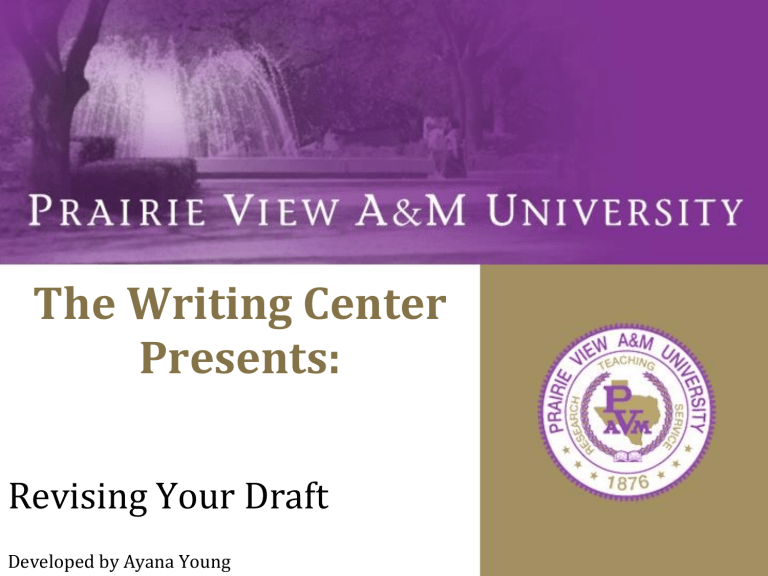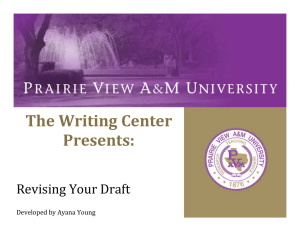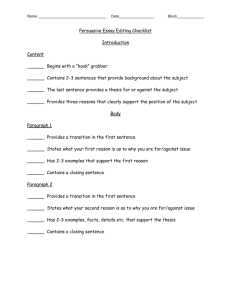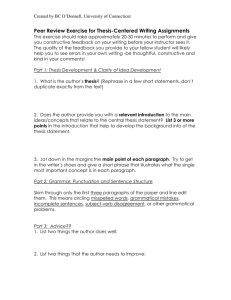The Writing Center Presents - Prairie View A&M University

The Writing Center
Presents:
Revising Your Draft
Developed by Ayana Young
What is Revision?
• The process of correcting your spelling, punctuation, and mechanics is called editing. A lot of people confuse the two.
• In revising, you are making changes to either strengthen your thesis, provide better support, rearrange or reorganize paragraphs, incorporate new information, etc.
• In revising, look at your paper from the readers’ point of view.
Reader’s Point of View
• Ask yourself:
• Would a reader find your essay consistent?
Interesting? Convincing?
• Are there enough details, illustrations, facts, and evidence?
• Answering these questions may lead to a lengthy revision, so plan for time.
Outlining After the First Draft
• It may seem odd to make an outline after you have written the paper, but listing the main ideas and supporting details will enable you to review your essay quickly and easily.
• This step in the revision process is essential if you have written your first draft without an outline or detailed plan.
Making the Outline
• An outline allows you to check for sufficient and logical development of ideas as well as for unity throughout the essay.
• Your introductory paragraph should contain your thesis, perhaps stated in a general way but stated clearly enough to let your readers know what your focus is
Making the Outline
1. Take a separate sheet of paper and write your thesis statement at the top.
2. Add the topic sentences stating the main idea of your paragraphs along with supporting points in each one.
• Your final paragraph should draw a conclusion concerning the thesis.
Checking the Outline
1. Make sure that the idea in every topic sentence is a significant critical observation relating directly to your thesis.
2. If not, revise the topic sentence until it clearly supports your thesis – or else delete the whole paragraph.
• Just as the topic sentence of each paragraph should relate to the thesis of the paper, every piece of supporting evidence should relate to the topic sentence.
Checking the Outline
3. In each body paragraph, examine your supporting details to be sure that each relates directly to the topic sentence.
4.Make sure that none of your points repeats an idea included elsewhere (unless you are repeating for emphasis). Eliminate any careless repetition.
Checking the Outline
5. Decide whether your support is adequate. Think about whether you have included the most convincing details and whether you have enough of them.
6. If you don’t have sufficient support, rethink the point in order to expand it.
Rearranging for Conciseness
• A crucial part of revision involves giving some thought to the order of your paragraphs and the order of the supporting details within them.
Rearranging for Conciseness
• Two principles you need to consider are:
– Logic and Emphasis
– Both allow you to arrange ideas in a certain sequence.
Rearranging for Conciseness
1. You can arrange the paragraphs and details in order in which they appear in the work you are analyzing?
2. You can organize the descriptions in terms of space?
3. You can arrange your main points along a scale of value, of power, of weight, or of forcefulness?
Varying the Pattern
• The usual way of forming sentences in English is to begin with a subject, follow with the verb, and add a complement (something that completes the verb).
• Walter Mitty is not a brave person.
• Any time you depart from this patter, you introduce variety and emphasis:
• A brave person, Walter Mitty is not .
Which Words Should I Change
• You may have a good thesis and convincing, detailed support for it – but your writing style can make the difference between a dull, boring presentation and a rich, engaging one.
Use Active Voice
• Although the passive voice sometimes offers the best way to construct a sentence, the habitual use of the passive makes your writing dull. If a sentence is in passive voice, the subject does not perform the action implied by the verb:
– The paper was written by Janet, Jo’s roommate.
– The assignment was given poorly.
– Her roommate’s efforts were hindered by a lack of understanding.
Use Active Voice
• The paper, the assignment, and the roommate’s efforts did not carry out the writing, the giving, or the hindering. In active voice the subjects of the sentences are the doers or the causes of the action:
– Jo’s roommate Janet wrote the paper.
– The teacher gave the assignment poorly.
– Lack of understanding hindered her roommates efforts.
Avoid Nominalizing
• Nominalizing is when you transform verbs and adjectives into nouns
• Faulty: We conducted an investigation of the accident.
Better: We investigated the accident.
Emphasize Important Words
• Place words where they receive natural stress, either at the beginning or, for even greater emphasis, at the end of a sentence:
• Faulty: Rather than being a judge who pronounces the verdict, the teacher becomes an editor who guides students' writing with this method.
Better: With this method, the teacher becomes an editor who guides students' writing, rather than a judge who pronounces the verdict.
Feel the Words
• Words have emotional meaning (connotations) as well as direct dictionary meanings
(denotations).
• Always take into account the emotional content of the words you choose.
Use Formal Language
• College essays require the use of formal language, a style that takes a serious or neutral tone and avoids such informal usage as contractions, slang, and sentence fragments, even intentional ones.
• Formal writing often involves third-person point of view.
Tone
• The reflection of the writer’s attitude
• This can be described in terms of emotion:
– Serious, solemn, satirical, humorous, sly, mournful, expectant, etc.
Variations in tone, conveyed by word choice, reflects the writer’s attitude.
Remain unbiased
Control the tone of your writing. Once you’ve established a tone, continue with it throughout the paper.
All Information Obtained From:
• McMahan, Elizabeth, Susan X. Day, and Robert
Funk. Literature and the Writing Process.
Fourth ed. New Jersey: Prentice Hall, 1996.
Print.
• http://www.studygs.net/writing/revising.htm
The Writing Center Contact Info
Prairie View A&M University Writing Center
Hilliard Hall, Room 118
(936) 261- 3724
• writingcenter@pvamu.edu
• http://www.pvamu.edu/pages/4399.asp





